
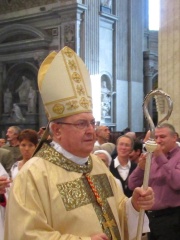
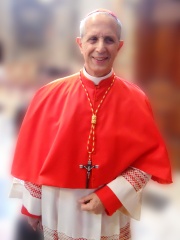
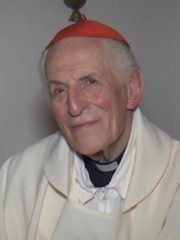

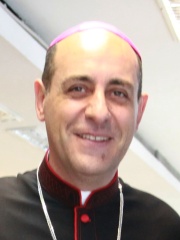
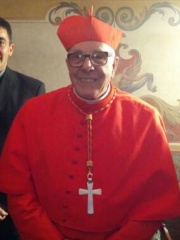
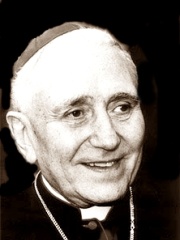
The Most Famous
RELIGIOUS FIGURES from Argentina
This page contains a list of the greatest Argentinean Religious Figures. The pantheon dataset contains 3,187 Religious Figures, 12 of which were born in Argentina. This makes Argentina the birth place of the 36th most number of Religious Figures behind Canada, and Philippines.
Top 10
The following people are considered by Pantheon to be the top 10 most legendary Argentinean Religious Figures of all time. This list of famous Argentinean Religious Figures is sorted by HPI (Historical Popularity Index), a metric that aggregates information on a biography's online popularity. Visit the rankings page to view the entire list of Argentinean Religious Figures.

1. Pope Francis (1936 - 2025)
With an HPI of 97.04, Pope Francis is the most famous Argentinean Religious Figure. His biography has been translated into 175 different languages on wikipedia.
Pope Francis (born Jorge Mario Bergoglio; 17 December 1936 – 21 April 2025) was head of the Catholic Church and sovereign of Vatican City from 13 March 2013 until his death in 2025. He was the first Jesuit pope, the first Latin American, and the first born or raised outside Europe since the 8th-century Syrian pope Gregory III. Born and raised in Buenos Aires, Argentina, to a family of Italian origin, Bergoglio was inspired to join the Jesuits in 1958 after recovering from a severe illness. He was ordained a Catholic priest in 1969, and from 1973 to 1979 he was the Jesuit provincial superior in Argentina. He became the archbishop of Buenos Aires in 1998 and was created a cardinal in 2001 by Pope John Paul II. Following the resignation of Pope Benedict XVI, the 2013 papal conclave elected Bergoglio as pope on 13 March. He chose Francis as his papal name in honor of Saint Francis of Assisi. Throughout his papacy, Francis was noted for his humility, emphasis on God's mercy, international visibility, commitment to interreligious dialogue, and concern for the poor, migrants, and refugees. He made women and laymen full members of dicasteries in the Roman Curia. He believed the Catholic Church should demonstrate more inclusivity to people with same-sexual attraction, and stated that although blessings of same-sex unions are not permitted, individuals in same-sex relationships can be blessed as long as the blessing is not given in a liturgical context. He also convened the Synod on Synodality, which was described as the culmination of his papacy and the most important event in the Catholic Church since the Second Vatican Council. He was well known for having a less formal approach to the papacy than his predecessors by, for instance, choosing to reside in the Domus Sanctae Marthae guesthouse rather than in the papal apartments of the Apostolic Palace used by previous popes. In addition, due to both his Jesuit and Ignatian aesthetic, he was known for favoring simpler vestments devoid of ornamentation, including refusing the traditional papal mozzetta cape upon his election, choosing silver instead of gold for his piscatory ring, and keeping the same iron pectoral cross he had as cardinal. Concerning global governance, Francis was a critic of trickle-down economics, consumerism, and overdevelopment; he made action on climate change a leading focus of his papacy. He viewed capital punishment as inadmissible in all cases, and committed the Catholic Church to its worldwide abolition. Francis criticized the rise of right-wing populism and anti-immigration politics, calling the protection of migrants a "duty of civilization", and called for the decriminalization of homosexuality. In international diplomacy, he also helped to restore diplomatic relations between Cuba and the United States, negotiated a deal with the People's Republic of China to define Communist Party influence in appointing Chinese bishops, and encouraged peace between Israel and Palestinians, signing the Vatican's first treaty with the State of Palestine, as well from 2023, condemning Israel's military operations in Gaza; calling for investigations of war crimes. In 2022 he apologized for the Church's role in the cultural genocide of Canadian Indigenous peoples in residential schools. Francis made his last public appearance on Easter Sunday before dying on 21 April 2025, Easter Monday. The 2025 conclave elected Leo XIV as Francis's successor on 8 May. Leo XIV became the second pope from the Americas, after Francis.

2. Leonardo Sandri (b. 1943)
With an HPI of 69.74, Leonardo Sandri is the 2nd most famous Argentinean Religious Figure. His biography has been translated into 28 different languages.
Leonardo Sandri (born 18 November 1943) is an Argentine prelate of the Catholic Church who has been a cardinal since November 2007 and vice dean of the College of Cardinals since January 2020. He was prefect of the Congregation for the Eastern Churches from 2007 to 2022. He served in the diplomatic service of the Holy See from 1974 to 1991 in several overseas assignments, including as a permanent observer of the Holy See before the Organization of American States from 1989 to 1991, and in Rome as Substitute for General Affairs in the Secretariat of State from 1999 to 2007.

3. Mario Aurelio Poli (b. 1947)
With an HPI of 65.88, Mario Aurelio Poli is the 3rd most famous Argentinean Religious Figure. His biography has been translated into 25 different languages.
Mario Aurelio Poli (Spanish pronunciation: [ˈmaɾjo awˈɾeljo ˈpoli]; born 29 November 1947) is an Argentine prelate of the Catholic Church who was the Archbishop of Buenos Aires from 2013 to 2023. He was the Bishop of Santa Rosa from 2008 to 2013 and before that an auxiliary bishop in Buenos Aires from 2002 to 2008. Pope Francis, his predecessor in Buenos Aires, made him a cardinal in 2014.

4. Estanislao Esteban Karlic (1926 - 2025)
With an HPI of 64.64, Estanislao Esteban Karlic is the 4th most famous Argentinean Religious Figure. His biography has been translated into 20 different languages.
Estanislao Esteban Karlic (Spanish: [estanizˈla.o esˈteβan kaɾˈlitʃ]; 7 February 1926 – 8 August 2025) was an Argentine cardinal of the Catholic Church. He served as Archbishop of Paraná from 1986 to 2003, and was elevated to the cardinalate in 2007.
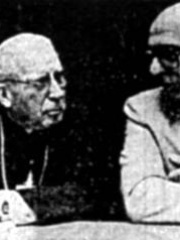
5. Juan Carlos Aramburu (1912 - 2004)
With an HPI of 63.05, Juan Carlos Aramburu is the 5th most famous Argentinean Religious Figure. His biography has been translated into 22 different languages.
Juan Carlos Aramburu (February 11, 1912 – November 18, 2004) was the Roman Catholic Archbishop of Buenos Aires, Argentina, from 1975 to 1990, and was named to the College of Cardinals by Pope Paul VI in 1976.

6. Antonio Caggiano (1889 - 1979)
With an HPI of 61.98, Antonio Caggiano is the 6th most famous Argentinean Religious Figure. His biography has been translated into 19 different languages.
Antonio Caggiano (30 January 1889 – 23 October 1979) was an archbishop and a cardinal of the Roman Catholic Church in Argentina. He played a part in helping Nazi sympathisers and war criminals escape prosecution in Europe by easing their passage to South America.

7. Víctor Manuel Fernández (b. 1962)
With an HPI of 61.82, Víctor Manuel Fernández is the 7th most famous Argentinean Religious Figure. His biography has been translated into 23 different languages.
Víctor Manuel "Tucho" Fernández (born 18 July 1962) is an Argentine prelate of the Catholic Church and a theologian. He is currently the head of the Dicastery for the Doctrine of the Faith. He served as rector of the Pontifical Catholic University of Argentina from December 2009 to April 2018. He was named Archbishop of La Plata on 2 June 2018. On 1 July 2023, Pope Francis named Fernández prefect of the Dicastery for the Doctrine of the Faith as of mid-September. Pope Francis made Fernández a cardinal on 30 September 2023.

8. Luis Héctor Villalba (b. 1934)
With an HPI of 61.00, Luis Héctor Villalba is the 8th most famous Argentinean Religious Figure. His biography has been translated into 20 different languages.
Luis Héctor Villalba (Spanish pronunciation: [lwis ˈeɣtoɾ βiˈʝalβa]; born 11 October 1934) is an Argentine prelate of the Roman Catholic Church who was the Archbishop of Tucumán from 1999 to 2011. He was an auxiliary bishop of Buenos Aires from 1984 to 1991 and bishop of San Martin from 1991 to 1999.

9. Eduardo Francisco Pironio (1920 - 1998)
With an HPI of 60.25, Eduardo Francisco Pironio is the 9th most famous Argentinean Religious Figure. His biography has been translated into 16 different languages.
Eduardo Francisco Pironio (3 December 1920 – 5 February 1998) was an Argentine Catholic prelate who served in numerous departments of the Roman Curia from 1975 to 1996. He was named a cardinal in 1976 and Cardinal-Bishop of Sabina-Poggio in 1995. Pironio died in 1998 and on 30 June 2006, the Diocese of Rome began requesting testimonies about his life and sanctity, opening his cause of canonization and bestowing upon him the posthumous title Servant of God. Pope Francis named him as Venerable on 18 February 2022.
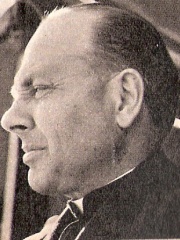
10. Raúl Francisco Primatesta (1919 - 2006)
With an HPI of 58.64, Raúl Francisco Primatesta is the 10th most famous Argentinean Religious Figure. His biography has been translated into 16 different languages.
Raúl Francisco Primatesta (April 14, 1919 – May 1, 2006) was a cardinal of the Roman Catholic Church of Argentina, and Archbishop Emeritus of Córdoba.
People
Pantheon has 12 people classified as Argentinean religious figures born between 1889 and 1962. Of these 12, 5 (41.67%) of them are still alive today. The most famous living Argentinean religious figures include Leonardo Sandri, Mario Aurelio Poli, and Víctor Manuel Fernández. The most famous deceased Argentinean religious figures include Pope Francis, Estanislao Esteban Karlic, and Juan Carlos Aramburu.
Living Argentinean Religious Figures
Go to all RankingsLeonardo Sandri
1943 - Present
HPI: 69.74
Mario Aurelio Poli
1947 - Present
HPI: 65.88
Víctor Manuel Fernández
1962 - Present
HPI: 61.82
Luis Héctor Villalba
1934 - Present
HPI: 61.00
Egypt at the 2020 Summer Olympics
HPI: 56.32
Deceased Argentinean Religious Figures
Go to all RankingsPope Francis
1936 - 2025
HPI: 97.04
Estanislao Esteban Karlic
1926 - 2025
HPI: 64.64
Juan Carlos Aramburu
1912 - 2004
HPI: 63.05
Antonio Caggiano
1889 - 1979
HPI: 61.98
Eduardo Francisco Pironio
1920 - 1998
HPI: 60.25
Raúl Francisco Primatesta
1919 - 2006
HPI: 58.64
Jorge María Mejía
1923 - 2014
HPI: 58.21
Overlapping Lives
Which Religious Figures were alive at the same time? This visualization shows the lifespans of the 7 most globally memorable Religious Figures since 1700.



